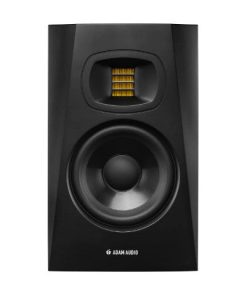Whitestone Audio WAI-P331-WH Whitestone Audio
$ 5.699,00 $ 1.424,75
P331 Tube Loading Amplifier – Class-A variable loading 6sn7 tube amplifier, Low distortion solid state output gain, Digitally controlled – Stereo/Dual Mono. 2U Rack
Both the Whitestone Audio P331 Tube Loading Amplifier and its “EVL twin” were developed to bring professional tracking, mix and mastering engineers versatile, elegant, precise and repeatable audio circuit variation. These are high-fidelity, hybrid vacuum tube /solid-state audio enhancement devices. They’re identical in their signal flow and control circuits, however we designed the P331-EVL to be more direct…more forward…less “polite” in its presentation.
So what are the differences?
Well let’s start with what’s the same. Like the original P331, the EVL version utilizes digitally controlled analog for all controls. Left/Right coherence is every bit as precise. The fully-differential solid-state output amplifier is unchanged. The LIFT circuit is also identical in both units, however, since the lifted frequencies are affected by the harmonics generated by the LOADING section…LIFT on the EVL will not sound exactly the same as the original P331.
The fully-differential tube LOADING amplifier in the EVL starts from a much different point. While the LOADING control is functionally the same as the original P331 in that it controls the 6SN7 tube’s operating point, it’s being pushed much harder from the start. It’s not like a distorted guitar amp…it’s still “mastering appropriate”. It’s simply a different, more forward “feel” than the original P331.
The XFORMER section is where the most differentiation occurs. We’re driving WAY more current at the EVL transformers …forcing them much further into saturation. The result is a more pronounced low-end presence, thrust and punch without becoming stuffy or losing clarity.
SOUL
In 1939, just a few weeks after the start of WWII in Europe, RCA Radiotron introduced the 6SN7 octal (8-pin) double triode tube to the American market. This was the birth of the true common ancestor of all modern double triodes used in high fidelity amplifiers. The 6SN7 is still in production after over 80 years, for good reason.
6SN7 vacuum tubes of the 1940s vintage were chosen for this amplifier due to their lower distortion capabilities that exceed that of the standard and ubiquitous 12A*7 variety. The 12A*7 varieties were incarnated due to commercial needs such that they were “better, cheaper, lighter” at the expense of embodying more distortion. With the advent of feedback, tube amplifiers could be mass produced with these less expensive 12A*7 style tubes using more feedback to reduce distortion.
While feedback reduces distortion, it also lowers overall amplifier gain. It might have been considered heresy to reduce the gain through feedback (and reduce distortion) in earlier tube designs since minimal gain was still extremely expensive prior to the 1950s. Thusly, earlier tube designs were lower distortion on purpose; especially for their critical role in modulation based communication systems that had more stringent requirements than the average 1950s guitar amplifier tube.
Notwithstanding, ultimate circuit topology can bring out more second harmonic characteristics than usual with any tube design. Hence the impetus for the variable circuit topologies within the P331 Tube Loading Amplifier to allow the user to do so as necessary or not at all.
HEART
For any amplifier to be truly great you have to start with good clean power. The P331’s linear power supply is the most critical “component” for audio integrity next to the actual gain structure and circuit topologies within this amplifier. High voltage plate/anode tube power supplies start at around 320V DC and are filtered (up to 6 times) and smoothed with active regulators. It only uses film capacitors and real inductors (chokes) to remove ripple and noise from the high voltage power supplies.
BRAINS
We’ve taken the very best of vintage analog technology and married it to the best of modern computer-optimized circuit design. This allows a level of precision and clarity which was simply unimaginable when tubes of this vintage were originally developed.
The P331 is full digitally controlled analog. Each parameter is fully repeatable and can be recalled via front panel rotary and toggle switches commanding over 80 sealed precision relays. No audio runs to the P331’s front panel and only the finest components are used throughout the audio path.
| Title | Default |
|---|
Prompt Delivery and Professional Packaging
Our long-standing partnership with UPS FedEx DHL and other global carriers lets us offer a range of shipping services. Our warehouse staff is extremely skilled and will package your items according to our precise and exact specifications. Your goods will undergo an extensive inspection and be safely packaged prior to being sent out. Each day, we ship to thousands of customers in many countries. The fact that we are committed to becoming the biggest online retailer in the World is clear. These warehouses are in Europe in the same way as they are in USA.
Note: Orders that include more than one item are assigned a processing period depending on the item.
Before shipping, we will inspect thoroughly the items you have ordered. Most orders are shipped within 48 hours. Expected delivery time is between 3-7 days.
Returns
Stock is dynamic. It's not entirely managed by us since we are involved with multiple entities, including the factory and the storage. The actual stock can change at any moment. It is possible that your order may be out of stock once the order has been placed.
Our policy lasts for 30 days. We cannot exchange or refund your order if it has been 30 days from the date of purchase.
For your item to be returned it must be in its original packaging, unopened and in the condition you received it. The item must be in its original packaging.
Related products
Accessories
Accessories
Equalizers
Accessories
500 Series
Recording Equipments
Mic Preamp
Headphones
Microphones
Microphones
Monitor Systems
Microphones
Monitor
Headphones
Microphones
Recording Equipments
Accessories
Microphones
Subwoofer
500 Series
Monitor Systems
Accessories
Monitor
Microphones
Mic Preamp
Microphones
500 Series










































































